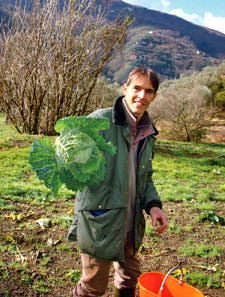
Text & Photos by Rick Gush
Alberto Cecconi comes from a family of gardeners and farmers; his farm is now organic certified and produces olives, vegetables and fruits. La Dolce Vita Rick Gush’s whimsical tales of farming Italian-style on his blog. |
It might not seem like farms in Italy have much to do with American farmers.
They have different markets, different crop varieties and, most importantly, different cultures. But still, farming is all about learning; learning from our neighbors, learning from farm consultants, and learning from our own mistakes and successes.
In this regard, it’s useful for American farmers to read a bit about farmers in Italy.
Although American farming is definitely the star of the world agricultural scene, we can’t rest on our laurels.
Competition from foreign producers and new pests is ever-increasing, and the pressures of staying alive can shake even the most confident farmer.
Survival skills is one thing that distinguishes Italian farmers; they’ve been farming for several thousand years—and you certainly don’t hear much complaining about the quality of the food they produce.
That said, American small farmers enjoy a number of advantages over their Italian counterparts. Nice, flat farmland is relatively abundant in the United States; there’s a wealth of university and cooperative extension scientific assistance available; and the commercial opportunities continue to increase for small farmers.
But Italian small farmers have always enjoyed one thing that American farmers are just beginning to realize—respect from the public.
Despite, or perhaps due to, the general Italian insistence upon extremely high food quality, small farmers in Italy enjoy appreciation from their customers that might be the highest in the world. The Italians’ preference for locally produced and seasonally appropriate foodstuffs is a centuries-old tradition, and the number of actively cultivated heirloom varieties of fruit, vegetable and animal products is remarkably high.
The Italian media reflects this reverence for the producers of food products, and every day, at least a dozen television shows feature segments in which small farm producers are showcased.
Small-plot cultivation of edible crops is a dominant feature of the social fabric of Italy, much more so than in the United States.
Cultivation of one’s own olives and vegetables is taken very seriously; a large number of citizens grow some of their own food.
Italians also eat more small-farmer-produced food, and the small farmers in Italy contribute a much higher percentage of the national total of consumed food than in other European Union (EU) countries and the United States.
The products of small and family-run agricultural enterprises are given governmental support through an active system of local certification, and these denominations are universally respected.
Fortunately for small Italian farmers, the worst part of the current crisis in the agricultural sector in Italy is mostly restricted to commercial agribusiness, where farms that bulk-ship their products beyond local markets are feeling the pressures from Chinese and East European producers who have recently begun supplying the same large commercial markets.
Farming the Hard Way
There’s not a lot of flat land in Italy, and it’s used predominantly by the agribusiness industry. The abundant, hilly land is where the majority of small farmers are active.
Some farmers have found small strips of flat land even in the mountainous areas, as the alluvial zones of the many creeks and rivers provide small, useable slices of flat land.
The general lack of available flat land is symbolic of the hard work involved in being a small farmer in Italy. Most small-scale farming is done on terraces created by piled-up rocks to make retaining walls. Luckily, farmers have been piling up rocks for a few thousand years in Italy, and modern farmers can take advantage of the many terraces made years ago.




